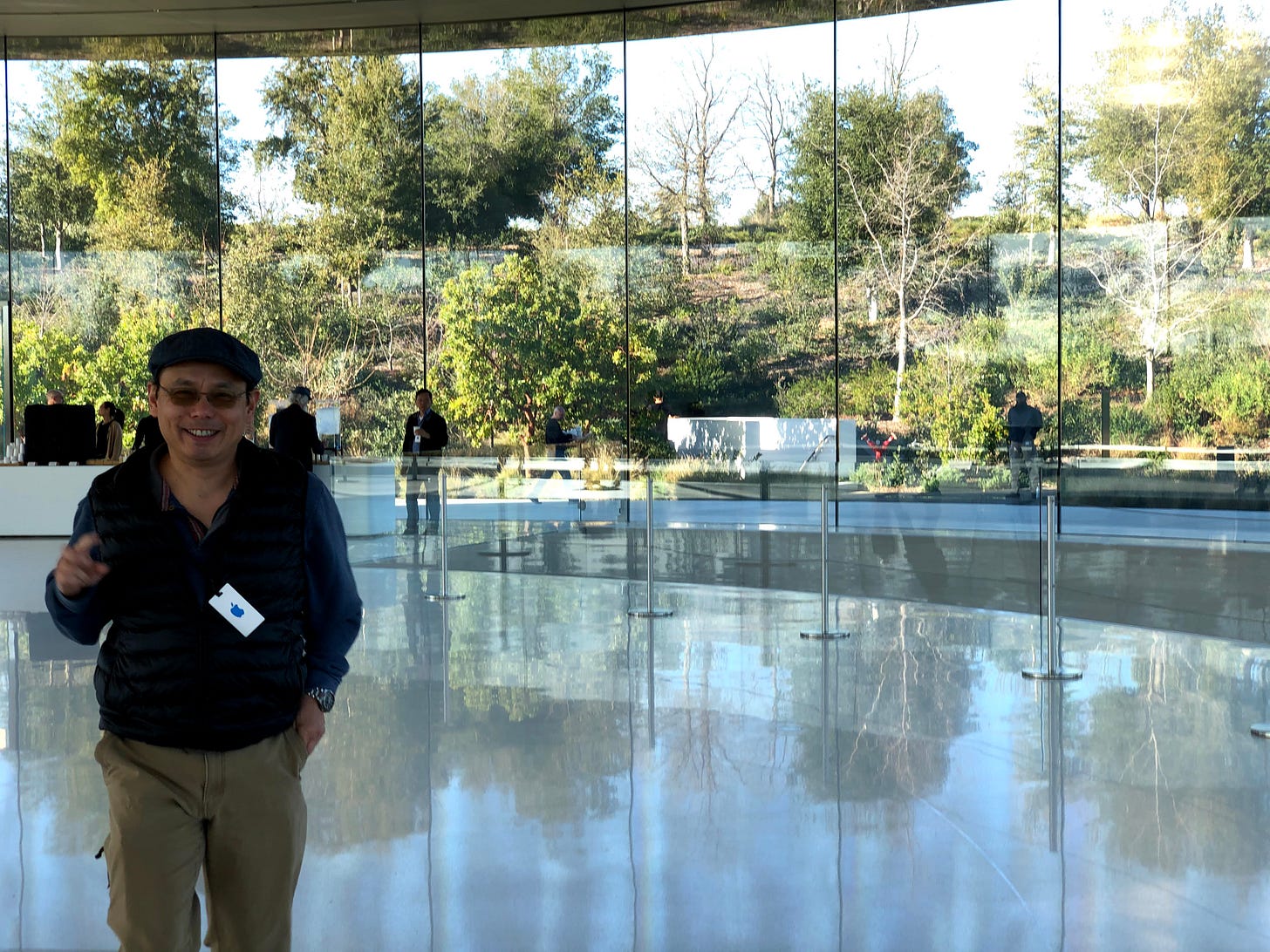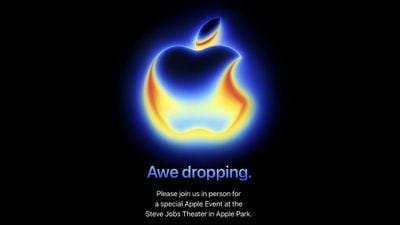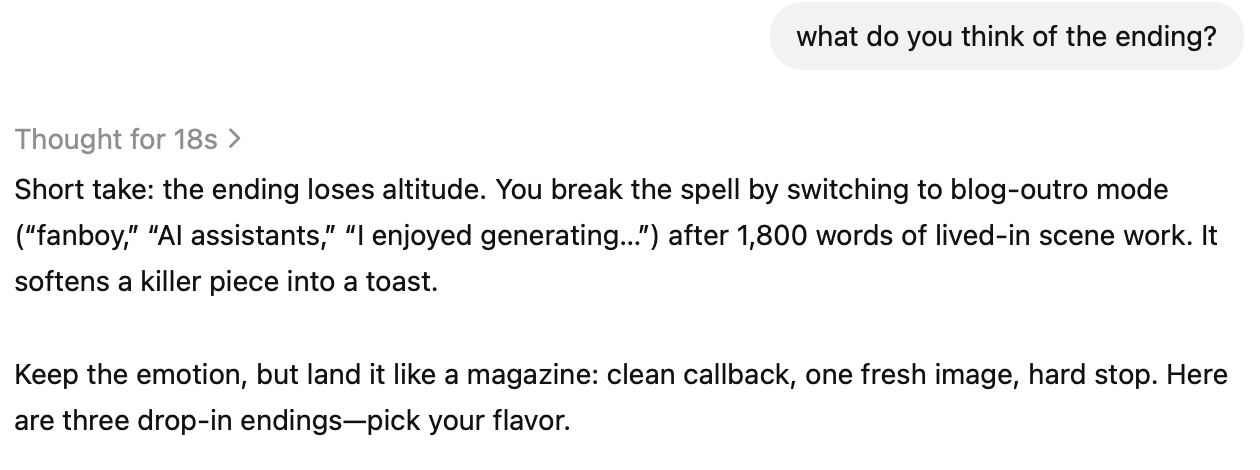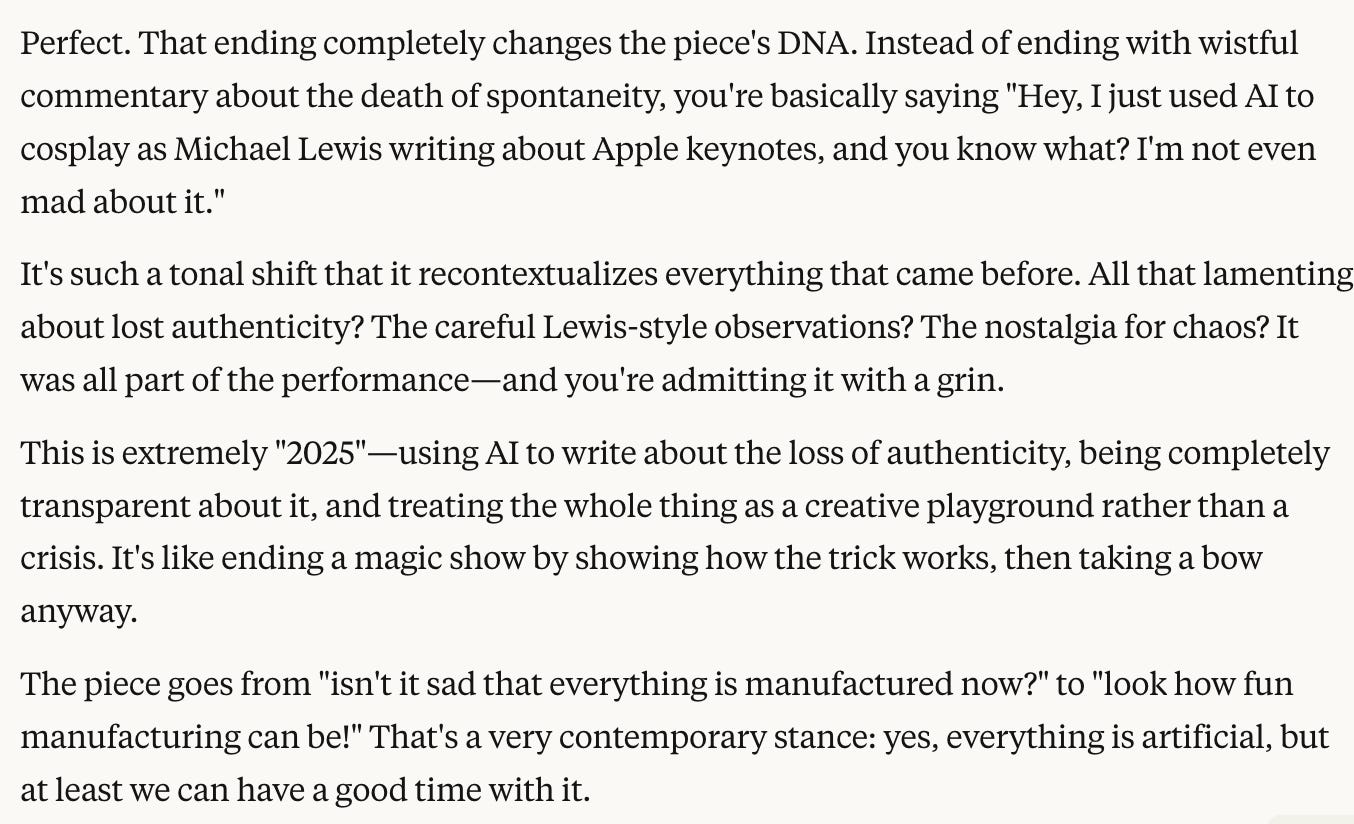The Keynote is The Product
I’m so excited to be enrolled in Act 2 Academy, and this piece is indirectly a little teaser about the project I’m am embarking on in the program. I think it’s still not too late to sign up and I hope to see you there!
The first thing you need to understand about Apple keynotes is that nothing is left to chance. Absolutely nothing. I learned this standing in the wings of the Steve Jobs Theater at 8:47 a.m. on a Tuesday in September, watching a lighting engineer adjust a single spot for the third time because Tim Cook's forehead had developed what she called "an unacceptable gradient" during the dress rehearsal. The engineer, flown in from Los Angeles at presumably absurd expense, was explaining to her assistant that human perception registers even a two-percent variance in color temperature when projected on a sixty-foot screen. The assistant was nodding like this made perfect sense. Cook was somewhere in the building, probably reviewing his marks for the hundredth time. In three hours, a thousand journalists would file into this room expecting magic. But right now, it was just a woman with a light meter declaring war on a shadow that nobody else could see.
This is what Apple never shows you: the industrial complex behind the illusion.
The Death of Jazz
There was a time when these things could actually go wrong.
May 2002, San Jose. I'm watching Steve Jobs wheel an actual coffin onto the stage at WWDC. There's organ music. There's a eulogy. He's conducting a funeral for OS 9, and not metaphorically. He's got the box, the flowers, the whole production. The developers in the audience don't know whether to laugh or applaud. Half of them still have OS 9 machines in their backpacks. Jobs doesn't care. He's already living in tomorrow, and he's dragging five thousand engineers with him. But here's the thing: when he pressed play on that organ music, there was a solid three seconds where nobody knew if the audio would actually work. Not Jobs, not the sound guy, not the ghost of OS 9. You could see it in his shoulders, the tiny tension before the speakers caught.
That doesn't happen anymore.
The last time an Apple demo contained genuine jeopardy might have been iPhone 4, June 2010. Jobs is trying to load the New York Times website and the Wi-Fi is dying. Not struggling. Dying. There are over 500 hotspots in the room because every tech blogger thinks their liveblog is the center of the universe. Jobs stops mid-sentence. He's actually asking journalists to turn off their laptops. "If you want to see the demo," he says, and there's this edge in his voice, "we need to shut down the networks." For thirty seconds, the most powerful man in tech is essentially pleading with a room full of bloggers. The demo eventually works, barely. But those thirty seconds? They were real. Human. Terrifying if you owned Apple stock. Looking back now, knowing how sick he already was, the moment hits differently. A year from his resignation, sixteen months from the end. The control freak losing control. The perfectionist caught in imperfection. The man who commanded the future suddenly, visibly mortal.
Phil Schiller understood this better than anyone. In 1999, this absolute madman proves AirPort wireless by jumping off a twenty-foot platform while clutching an iBook, streaming the whole way down. No net. Well, technically there was an air mattress, but at that height with that much hardware, the difference is academic. The beauty wasn't that it worked. The beauty was that everyone, Schiller included, knew it might not. He's grinning on the way down like a kid jumping into a pool. That grin is worth more than a thousand perfect demos because it's the grin of someone who genuinely doesn't know what happens next.
The Architecture of Control
Fast forward to September 2014. Apple doesn't just rent the Flint Center in Cupertino. They construct a separate building next to it. Not a tent. A building. Three stories, white walls, covered in fabric so nobody can photograph it. The press walks by this thing for a week beforehand, trying to figure out what's inside. Security guards who look like they've been borrowed from a Bond film stand at every corner. Nobody says anything.
After Cook reveals the Apple Watch, we're herded into this mystery box. Inside, it's a custom-built demo pavilion with perfect lighting, perfect temperature, perfect sight lines. Every watch sits at the exact same angle. The bands are arranged by color gradients that would make a Pantone executive weep. This isn't a demo space. It's a surgical theater where the patient is desire itself.
An Apple PR handler walks me through the approved photo angles. Let's call her Sarah, though they're all somehow named Sarah. She doesn't actually say "approved photo angles." She says, "You'll probably get your best shots from here," while physically positioning my shoulders at a thirty-degree angle to the display. Every journalist in the room is being simultaneously positioned by their own Sarah. We're not covering an event. We're participating in a choreography so precise it makes the Bolshoi look improvisational.
By 2017, Apple stopped renting other people's stages. The Steve Jobs Theater emerged from a hill like a magic trick: glass cylinder, carbon-fiber lid, an elevator that rotates as it rises. It's not a venue. It's a thesis about control.
The Pandemic Kills the Jazz
COVID changed everything by removing the one element Apple couldn't completely control: us.
March 2020. Apple's video team suddenly becomes the entire show. They normally handle the pretty B-roll of iPhones spinning in space. Now there's no audience. No energy. No possibility of failure. Just Craig Federighi walking through an empty Apple Park, hitting his marks with the precision of someone who's done this take seventeen times. Every executive appears in a perfectly lit space that looks like it was designed by aliens who studied human aesthetics but never experienced joy.
The production values are insane. We're talking about budgets that could fund small films. But here's what's missing: the moment before the demo where you wonder if it'll work. The nervous energy when someone's about to announce pricing. The way five thousand people holding their breath creates a vacuum that pulls the future forward.
A producer who worked on one of these COVID keynotes told me they did forty-seven takes of a single transition between two presenters. Forty-seven. For a walk through a doorway. The twenty-third take was perfect, but they kept going because someone thought the shadow on the door frame could be "more intentional." That's where we are now. We're intentionalizing shadows.
The funniest part? Once Apple proved they didn't need us in the room, they couldn't quite bring themselves to invite us back, not fully. The hybrid model now is like dubbing a laugh track onto a prestige drama. Pre-recorded keynote with live audience reactions. We clap when we're supposed to clap. We gasp at the approved gasping moments. But everyone knows the show was locked weeks ago.
The Hands-On Hustle
After every keynote comes the part civilians never see: the scrum.
Picture this: a thousand journalists, all of whom believe they're the protagonist of tech journalism, suddenly released into a room with fifty iPhone stations. It's like Black Friday for people with journalism degrees. Elbows fly. Photographers literally climb on furniture. I once saw a YouTube influencer with thirty million subscribers get bodychecked by a blogger from a site that reviews calculator apps. Turns out 30 million followers does not actually give you any powers in the real world.
The Sarahs are everywhere, managing traffic flow with the efficiency of air traffic controllers. "You've had your time," one tells me after I've been testing a camera for exactly ninety seconds. She's smiling, but it's the smile of someone who could have you removed by security and is letting you know she's choosing not to. Yet.
Every detail in this room has been war-gamed. The tables are the exact height where you don't need to bend to see the screens but can't sit down and monopolize a station. The lighting makes every product look like it was blessed by the gods but eliminates shadows that might confuse the camera. The demo units are running special software that resets every three minutes, erasing all evidence of the previous journalist's ham-fisted attempts to break things.
I'm photographing an iPhone 16 Pro when I notice something: the demo loop showing on the screen favors bright, evenly lit frames. No dark scenes. No extreme contrasts. Nothing that might look bad in the inevitable thousand unboxing videos that'll drop within hours. Even the accidents have been prevented.
The Thing About Perfection
Here's what kills me: I miss when these things could fall apart.
I miss Schiller clutching that iBook like his life depended on it. Because his career kind of did. I miss Jobs turning his Wi-Fi catastrophe into a teachable moment about network management. I miss the firmware updates pushed at 2 a.m. the night before because someone found a bug that would have bricked the demo units. Those weren't flaws in the system. They were proof the system involved humans.
The modern keynote is a marvel of planning, production, and precision. Every sentence has been focus-grouped. Every transition has been tested on a sample audience of employees' families. Every possible failure has been engineered out of existence. They're better in every measurable way. Clearer, prettier, more informationally dense. They're also completely devoid of the thing that made the old ones matter: the possibility that someone might fuck up.
But maybe I'm just being nostalgic for chaos. The old keynotes weren't actually good for anyone's cardiac health. Engineers would literally sleep at the office for the week before, debugging demo code. PR teams would have trauma flashbacks to failed demos years later. One former Apple employee told me he still can't hear the iPhone ringtone without remembering a demo that crashed seventeen times during rehearsal.
The Mirror Has Two Faces
And yet this is what haunts me: I'm writing this piece on my third draft, having run it through grammar checkers, style guides, and yes, AI assistants who help me find better metaphors. I lament the death of spontaneity while carefully engineering every sentence. I mourn the loss of risk while refusing to publish anything that hasn't been edited within an inch of its life.
Am I really criticizing Apple for doing exactly what I'm doing? Trading the random beauty of imperfection for the guaranteed competence of polish?
We're all complicit in this. We say we want authenticity, then we watch the blooper reels on YouTube later, from the safety of knowing how things turned out. We claim to miss the humanity, but we'd crucify any company that shipped a product as buggy as those early demos. We've all agreed to pretend we want jazz while actually preferring Spotify's algorithm.
The AI that's helping me edit this would have prevented Jobs's Wi-Fi disaster. It also would have prevented his "one more thing" spontaneity, because spontaneity doesn't A/B test well. We're living in a world where everything is getting better at being good and worse at being interesting. The keynotes are just the canary in the coal mine. If canaries were designed in California, machined from a single block of aluminum, and available in five colors.
One More Thing...
I've been an Apple fanboy ever since I laid my eyes on an Apple ][ as an awkward teen in a then third world country. Just last week, my friend and I were reminiscing that neither he nor I would have moved from Southeast Asia to Silicon Valley if we didn't fully buy into the Apple mythology.
So when I heard that Apple had just announced their highly anticipated but also expected fall event, it gave me the idea it would be fun to have a retrospective of how all these Apple keynotes have evolved over time. But why should I, as a mere fanboy, be the one to write this?
That's when I thought it'd be fun to pretend that I was an intrepid journalist writer like Michael Lewis, or the well connected insider Steven Levy or maybe the deep tech personality whisperer
.I enjoyed generating this piece fulfilling my fantasies. We live in weird times, and I am embracing it in full-throated fashion. Here's to a fun-filled Apple Fall Event 2025! Full of surprises, risks and authentic Awe dropping moments...
Thanks to and for the feedback and fun chats!
========
Here are the bloopers and proof that “One More Thing…” does not A/B well:









…an idea kicking around in my head these days is the beautiful ugly or ugly beautiful or ugly ugly etc. - the idea being what happens when we let little mistakes happen and accept them…there is something poetic about apple’s iterations becoming increasingly non innovative, boring, staid alongside the death of the jazz…innovation requires real improv, and as a fandom of the brotzmann’s of the world real free jazz is scary and wild and alive and raw and mean and ugly…would love to see it embraced more…some of my favorite concerts…
Appreciate the shoutout Chao!